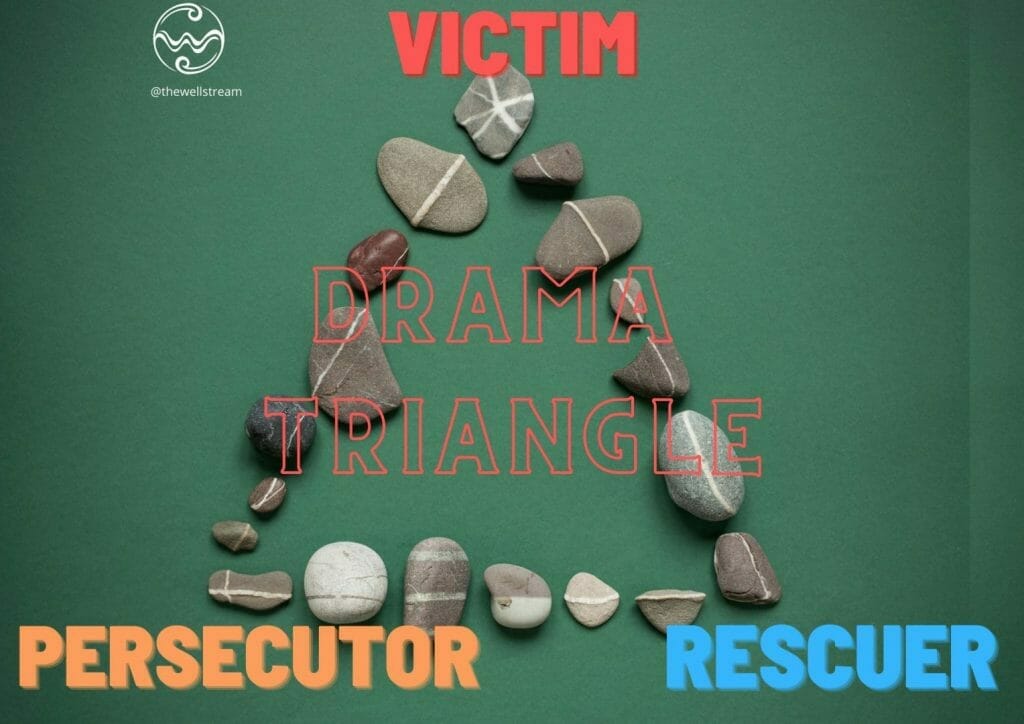Table of Contents
Are you a drama addict? I lived within the effects of the Drama Triangle for years before I was taught what it was, what it meant, and how to end the cycle of co-dependent instability that it describes. In this article I want to outline the Drama Triangle, but in particular I want to describe what it felt like to be inside it.
At its heart the ‘Karpman’ Drama Triangle, created by Dr. Stephen Karpman in 1968 (also called the ‘Victim Triangle’) outlines a way of relating to another person that is both enthralling and destructive. Sometimes it is called the Victim Triangle, as it centers on victimisation.
What is the Drama Triangle?
A Drama Triangle is a widely used tool for helping people overcome and escape negative patterns of interaction, communication, and relation. The Drama Triangle describes a toxic cycle of co-dependence that can arise in your relationship quite easily.
Drama Triangles are not confined to any particular type of relationship. They can crop up between families, friends, colleagues, romantic partners… basically any relationship you can think of. You can even be part of a Drama Triangle starring only you, in which case the patterns play out in the relationship you have with yourself.
It is perpetuated when people, usually a ‘dynamic duo’, take turns to play the roles of Victim, Persecutor, and Rescuer opposite each other. These roles are described in the accompanying images and in short below:
Victim
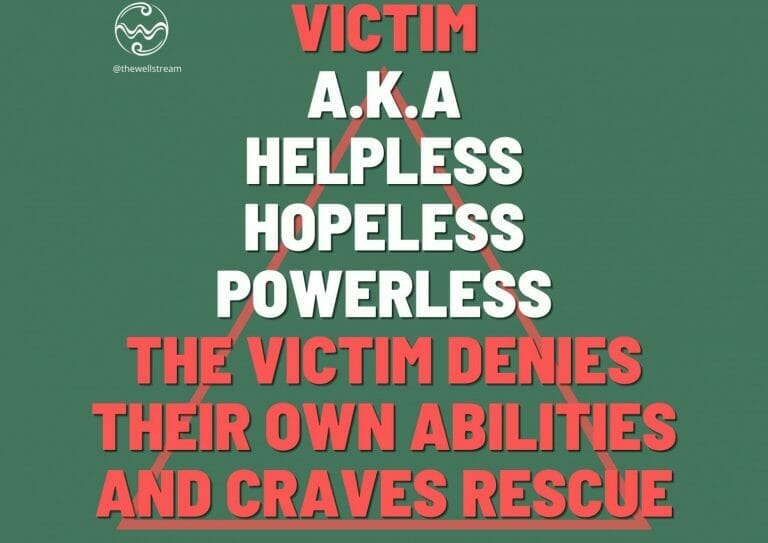
Victims act as if they cannot possibly solve their own problems. They will often seek to stay the same and create justifying excuses to avoid growth.
A victim wants other people to act or to change for them: they avoid responsibility or taking control of their own situation. Victims often externalise difficulties, placing them outside of their power, and create self-fulfilling loops to justify inaction (e.g. I didn’t get X because the system is unfair, and because it is unfair I won’t try to get X again).
It is important to know that victims don’t want any-old help, they want to be helped in very specific ways. Even though the victim acts powerless, they actually hold all the cards and seek to manipulate others into doing the things they feel incapable of doing for themselves.
Persecutor
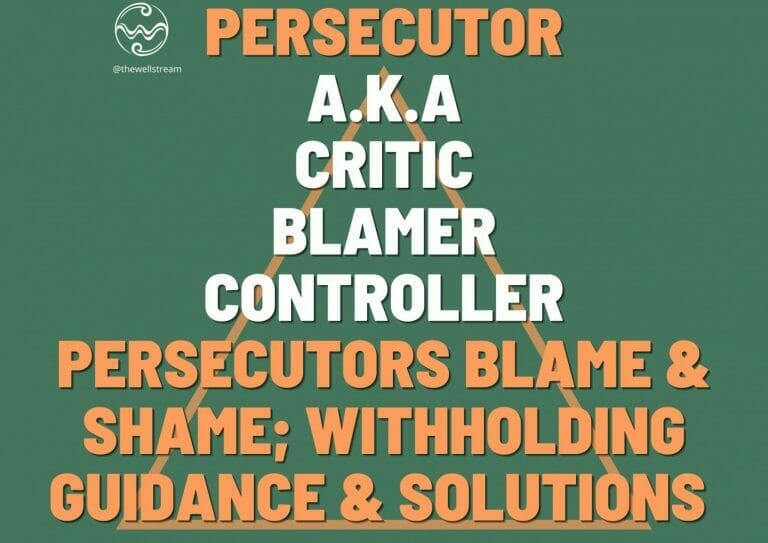
Persecutors are motivated by a desire to feel powerful, significant, and in control. Unfortunately, they seek to realise these feelings by causing suffering for others; i.e. they seek to put other people down rather than raise themselves up.
The persecutor role reinforces the role of the Victim through their negative or abusive actions. They don’t consider the feelings of others and can not hear or accept the word “No”.
Rescuer
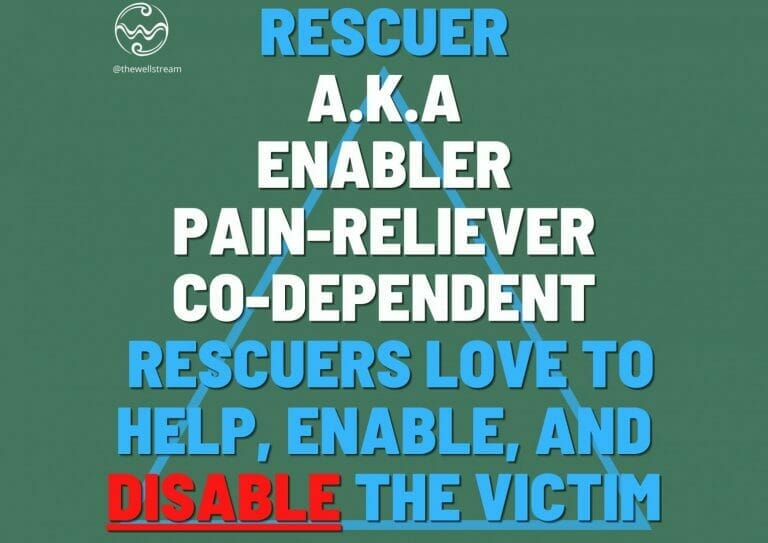
Rescuers seek to help those in need, at least on the surface. Often they have a deeper motivation (that they may not be aware of) to feel worthy, superior, and needed by others.
This works perfectly for the Victim as Rescuers tend to take over the thinking and problem solving. In effect this disables the Victim and blocks them from being able to act towards their own needs. This dual-enablement can create an immensely strong co-dependent bond between Victim and Rescuer, for a time at least.
Ultimately rescuers often pour all their energy into ‘fixing’ the Victim and fail to account for their own needs. Rescuers may eventually burn out, and, once they can no longer assist the Victim, are rejected. On the other hand a Rescuer may smother a Victim who is actually trying to help themselves, acting more like a Persecutor as they seek to keep the victim powerless.
Bystander
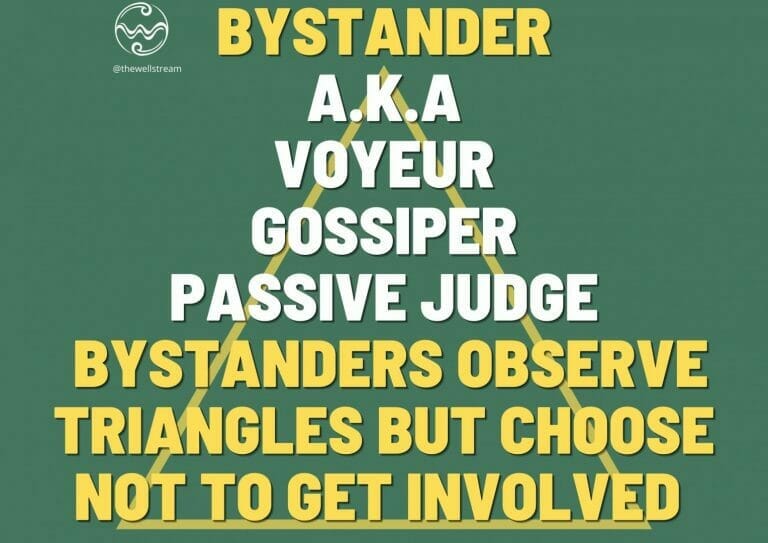
Additionally there is the fourth, and lesser, role of Bystander: those who are aware of the drama but choose to do nothing. Bystanders may seek to avoid the Drama Triangle completely, or they may participate passively: spreading gossip or creating the conditions for the Drama Triangle to thrive.
The important thing to realise about the three major roles is that they are dynamic: the persons trapped inside the Drama Triangle will swap roles in order to perpetuate co-dependence.
Lack of awareness is a characteristic of the Drama Triangle and the people trapped inside it are often unconscious of the larger dynamic. This results in swapping of roles automatically and without realisation, as each person reacts to each other.
This lack of awareness is what makes the Drama Triangle so hard to see from within, even if it is obvious to outside observers.
Two examples from my life to illustrate the Drama Triangle
The first Drama Triangle I was a part of I predominantly occupied the roles of Victim and Rescuer. My Persecutor would belittle me (victimising me) and I would respond by trying to forgive them and help them change i.e. I wanted to rescue them so that they would rescue me!
Sometimes my temper and patience would reach their limits; I would snap and give the Persecutor a piece of my mind. But when this happened they, like a choreographed dancer, would effortlessly slip into the role of the Victim; claiming that they were unaware, that they hadn’t tried to hurt me, and that I was being unfair.
In a way they were still persecuting me by ‘gaslighting’ (questioning my memories and perception of reality).
This shows how complex these relationships can be, with a person presenting multiple roles simultaneously as a means of defense.
Unfortunately this first Drama Triangle lasted for many years and made the relationship impossible to sustain long-term. Thankfully, I eventually realised that the one I needed to rescue from the situation was myself.
My second Drama Triangle was more equal. We both seemed to occupy all three roles but this in turn made it far more complex. In fact it was the endless repetition of rescuing each other that often made us feel close, even if at the core it was deeply unhealthy because it meant we needed things to be rescued from.
Through the Triangle’s dynamic the relationship never felt really stable. Like binary stars we seemed to be orbiting each other, so that as one of us became happy the other became sad, or as I would expand they would shrink: not always – but often enough. It was as if it were impossible to occupy the same emotional space and this created an enormous tension between us that I thought of as an unbridgeable distance.
In the beginning I acted as the persecutor for both of us (persecuting myself and them) but as we put more mileage on the relationship they were able to persecute me too.
I can’t claim to perfectly understand it all, even now, but at the time it seemed like a puzzle I was always one step away from solving – and that was true! We were always one step away from each other, waltzing around the triangle persecutor-victim-rescuer, indefinitely and in ever widening arcs.
What did it feel like to be inside the Drama Triangle?
Essentially: stuck. Nothing I did seemed to make a lasting difference, and I am sure my partners-in-drama felt the same. It was like we were playing chess but had both been at check-mate from the start: we kept making moves but nothing changed the inescapable cycle we had created.
One way it made me feel, and I recognised this quickly, was I felt like an out-of-date photograph. I felt like they could only see me for who I used to be, and not who I had become. Once my counselor taught me about the ‘Victim Triangle’, as they called it, I started to ask these two questions: ‘Can I see them for who they are now? Can they see me as I am now?’
I think this is common in families where parents sometimes hold on to the image of their children and can’t see them as capable adults (and children can’t see their parents as flawed adults). I am definitely guilty of this as well, holding on to an idea of who a person was at the expense of who they are now. Perhaps it is because the Drama Triangle overall functions to prevent personal growth, and so while caught within it I was unable to acknowledge that either of us had grown.
I also felt a deep sense of futility that the outcomes of my interactions were inevitable. I could predict the course of events or conversations because I had memorised all the patterns.
Strangely enough, even seeing and communicating the pattern consciously beforehand didn’t seem to effect outcomes. It was as if nothing could shift the Drama Triangle from within, and every action we took just caused more drama. Like being put on circular train-tracks – we always ended up in the same place and this made me feel hopeless and very fatalistic.
The last way that I remember feeling is addicted or obsessed. The Drama Triangle was the ultimate puzzle and I was constantly thinking about how to overcome it. Unbeknownst by me, what I was really doing was feeding more and more energy into it and making it stronger and more real to my mind.
This had the additional negative impact of entrenching unhealthy thought patterns and ruminations, causing me to turn inwards when help and growth only existed outside.
How can we dismantle and escape the Drama Triangle?
For me the key was awareness of my self and the situation.
Before I learned what the Drama Triangle was, I simply couldn’t see outside of it. Every option I considered was conceived within the confines of toxic co-dependence. In short, I couldn’t see the wood for the trees.
Once I could see how the dynamic worked I began to understand it and make progress towards helping dismantle it.
The thing about the Drama Triangle is that it breaks down when we stop playing the major roles. If we aren’t running in the hamster-wheel the dynamic grinds to a halt. This doesn’t mean that we won’t experience a lot of internal and external pressure to resume those roles, but getting out for a moment is a good first step.
Essentially you want to not-react and replace the roles of Victim, Persecutor, and Rescuer with those of a Vulnerable Person, an Assertive Person, and a Caring person (more on this by following the link at articles end).
In practice this is made especially difficult if our roles within the Drama Triangle are tethered to strong emotions, pain, or past-trauma. Dealing with these can easily trigger us back into the easy and familiar roles we are trying to escape. It is in these situations where seeking additional support or guidance, e.g. from a counsellor, can make a world of difference.
Counselling support helped me to make sense of my own Drama Triangles, understand my role in them, and ultimately dismantle and escape from them.
I think this extra experience and wisdom is especially important for young people who can’t see the dynamic that is affecting them. Now-days I can spot a Vitim, Persecutor, or Rescuer a mile off, but that is only because I had help and support when I needed it.
To sum up the sequence of learnings that helped me escape the Drama Triangle:
- Becoming aware of the Drama Triangle, the major roles, and the roles that I tended to play the most; combining self-awareness with situational awareness and a new framework for my relationships.
- Taking responsibility and ownership for my part in creating and perpetuating the situation.
- Getting enough space and support to be able to not-react when communicating or relating to the other.
- Trying to hold a constructive role in communications to break the triangle altogether (this takes consistency and practice, often from both people – I found it very difficult).
- Putting limits, or boundaries, on how far I was willing to go to try and salvage things.
- Asking myself those same questions regularly ‘Can I see them for who they are now? Can they see me as I am now?’ to try and get a gauge of whether progress was being made.
Has my Drama Triangle journey changed my world view?
Yes. These days I am a better person, and a better communicator, because I understand what it means to be a Victim, Persecutor, or Rescuer compared to Vulnerable, Assertive, and Caring.
I place fewer demands on people and have more boundaries about the demands that are made of me. I cultivate empty space inside my relationships to make sure we have enough room to be ourselves.
I still get people wanting to create new Drama Triangles with me, but I always shut them down at the start: I’ve had enough for a lifetime! As I mentioned, I can Identify Victims, Persecutors, and Rescuers predominantly by the way they make me feel, and I trust my emotions.
Drama Triangles are common, chances are you have been part of at least two by the time you are 25.
Like patches of quicksand: if you don’t know how to spot them you’ll accidentally end up in them. If you don’t know how to get out of them your struggle will just sink you deeper.
But if you do know what Drama Triangles and how you can manage them, it can transform all of your relationships (and all future relationships) for the better.
If you want to learn more about the Drama Triangle a good place to start is through the link below.

